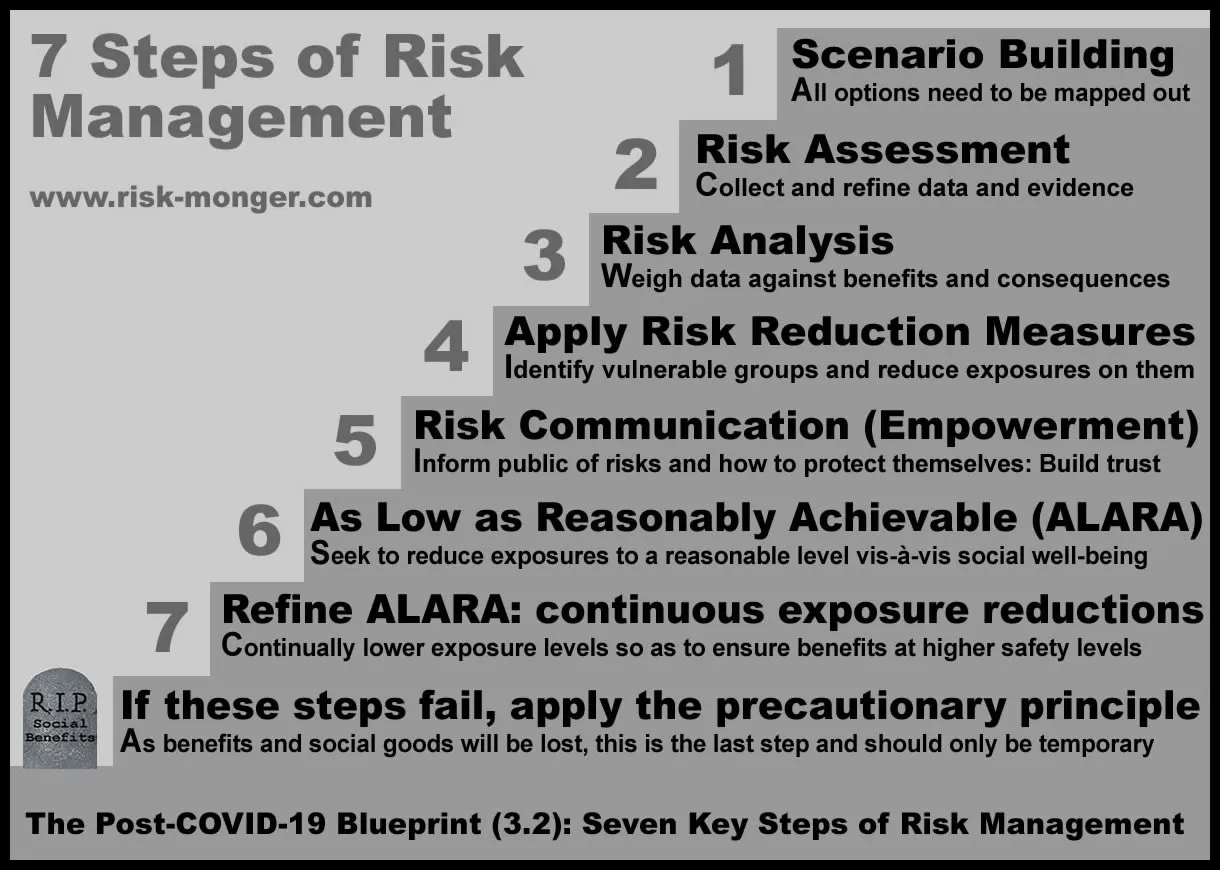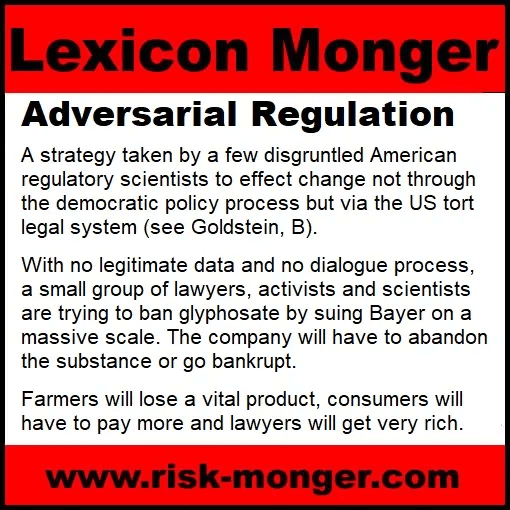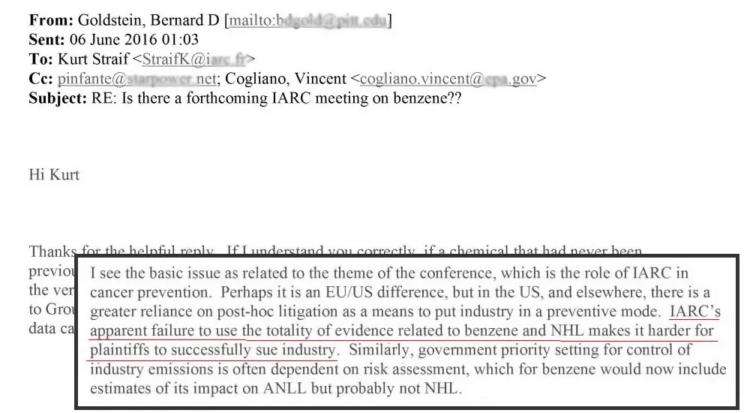
Today, though, there are a group of regulatory vigilantes attempting to overturn the traditional risk management process. Many of them, like Bernard Goldstein or Christopher Portier, were government-employed regulatory scientists in the 70s, 80s or 90s when the scientific evidence in their portfolios was clear (eg, on exposure risks from tobacco, chemicals, pesticides…) and as they prepared their dossiers and submitted sound policy advice, they would then have to stand aside to watch industry lobbyists come in at the last minute, disrupt their work and keep products on the market in return for some political favors or by playing one agency against another.
Now that these regulatory scientists are retired, they are bitter over what had transpired during their careers.
Adversarial regulation
The concept of “adversarial regulation” relies on using the courts via mass tort litigation to change the way people and companies act rather than trying to change laws and public policies. This approach acts to counter what these former regulatory scientists perceive as the failed regulatory risk management process. See my analysis of the different adversarial regulation documents.

As the La Jolla Playbook shows, this litigious strategy was what finally changed the game with Big Tobacco. If you try to protect consumers via the regulatory risk management process, lobbyists would just overturn your evidence with a political donation or a friendly director in high places. But if you bring a company to their knees via mass tort litigations, you have their attention (or the attention of their shareholders) and their willingness to comply.
But there is just one little problem with this alternative adversarial regulatory strategy: It is not very democratic.
Actually, there are many more problems with this approach. Scientists may disagree over the actual level of risk (as seen with cases like glyphosate and talc), tort law firms may cut a few research integrity corners to get their hands on a pot of gold and other companies and industries might use this motley crew to handcuff the competition and gain market advantage (eg, the organic food or renewables industries). The noble quest for justice and consumer protection has quickly been blurred by the seedy dash for cash and unseemly special interests.
Adversarial regulator: Bernard Goldstein
Bernard Goldstein, one-time EPA Assistant Administrator for Research and Development during the Reagan administration, has been the leading advocate for a “legal” and “adversarial” approach to science-based regulatory issues. Using his base of Collegium Ramazzini research fellows, many of whom are retired US regulatory scientists now serving as highly-paid litigation consultants to US tort lawyers, the strategy now is to move scientific debates into the courtrooms (where non-specialists on a jury will then determine whether a product should be on the market or a company has a right to exist).
The threat of incessant litigation has been identified as a more powerful policymaking tool in the US than the European use of the precautionary principle. Goldstein, in correspondence with a Ramazzini colleague, Kurt Straif (see image), once referred to adversarial regulation as a “reliance on post-hoc litigation as a means to put industry in a preventative mode”. What does this “preventative mode” mean? That they will abandon certain products or markets? That they will ensure product safety and clear risk communication? This used to be the role of regulatory risk managers but it seems to have been replaced by a thug-like process of greedy tort opportunists bullying selective innovators into submission.
Is adversarial regulation really a better approach? Despite his long policy career, Bernard Goldstein does not seem to understand how research and data, at any level of involvement with politics, will get messy. Seeing how Trump weaponized the EPA with his political network can be frightening, as he recently wrote, but these momentary interruptions do not change the scientific facts and the methodology of self-correction. Goldstein used Trump as a reason to propose to further legalize the risk assessment process. But as this La Jolla series has seen with the recent US tort cases on glyphosate and talc, moving the process into the courtroom and leaving decisions on product safety up to non-specialist juries is even messier. The only reason this policy shift would be appealing is if you are more triggered by industry scientists than populist preachers.

Goldstein, of course, has been caught with his pants down, using his connections to get the International Agency for Research on Cancer (IARC) to hold a third (unscheduled) working group to produce a monograph linking benzene exposure to Non-Hodgkin Lymphoma because the law firms he was working with needed to have a research document to justify a series of lawsuits claiming that. See image above. In an interesting exchange following my exposé, Goldstein indicated that he saw nothing wrong with his actions nor that his remuneration and conflicts of interest might have led him to act unscientifically.
Adversarial regulation in La Jolla
The La Jolla Playbook has little respect for the regulatory risk management process or, for that matter, the democratic policymaking approach. It is able to harness political results by exploiting the greed and opportunity of all interest groups involved. Having some self-interested litigation consultant scientists publish papers trying to legitimize this adversarial approach as more effective than the democratic regulatory process adds value to the activist ambitions of the La Jolla group.
The Ramazzini-focused circle of retired regulatory scientists provide a fertile ground of high-level expertise for tort law firms attacking big corporations They fervently believe that a small group of individuals, should, behind closed doors, be able to change policies that affects millions of people. They also bring to the conversation a high level of rage and resentment from their personal career failures.
Vengeance is a great motivator and opportunists in the tort law industry have been quick to capitalize on that.
David Zaruk is the Firebreak editor, and also writes under the pen-name The Risk Monger. David is a retired professor, environmental-health risk analyst, science communicator, promoter of evidence-based policy and philosophical theorist on activists and the media. Find David on X @Zaruk
A version of this article was originally posted at The Firebreak and has been reposted here with permission. Any reposting should credit the original author and provide links to both the GLP and the original article. Find Firebreak on Twitter @the_firebreak































